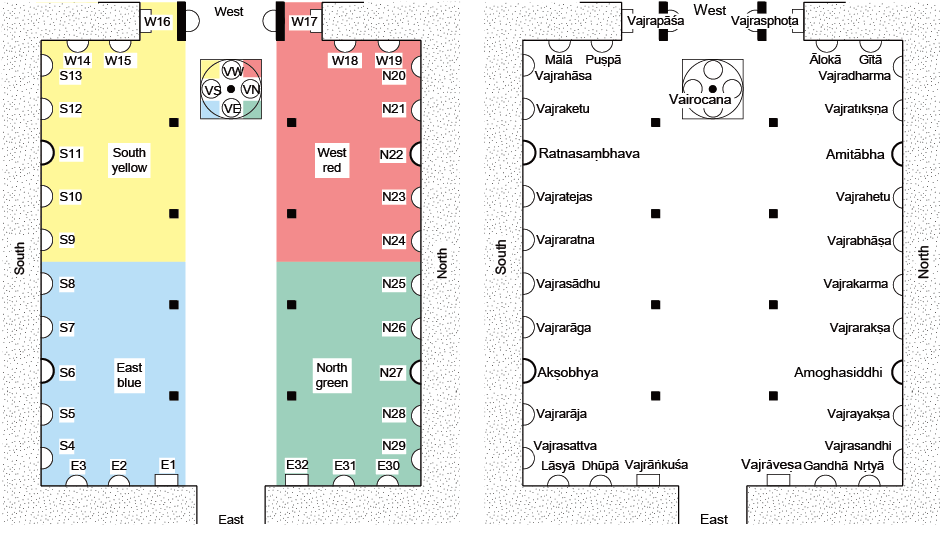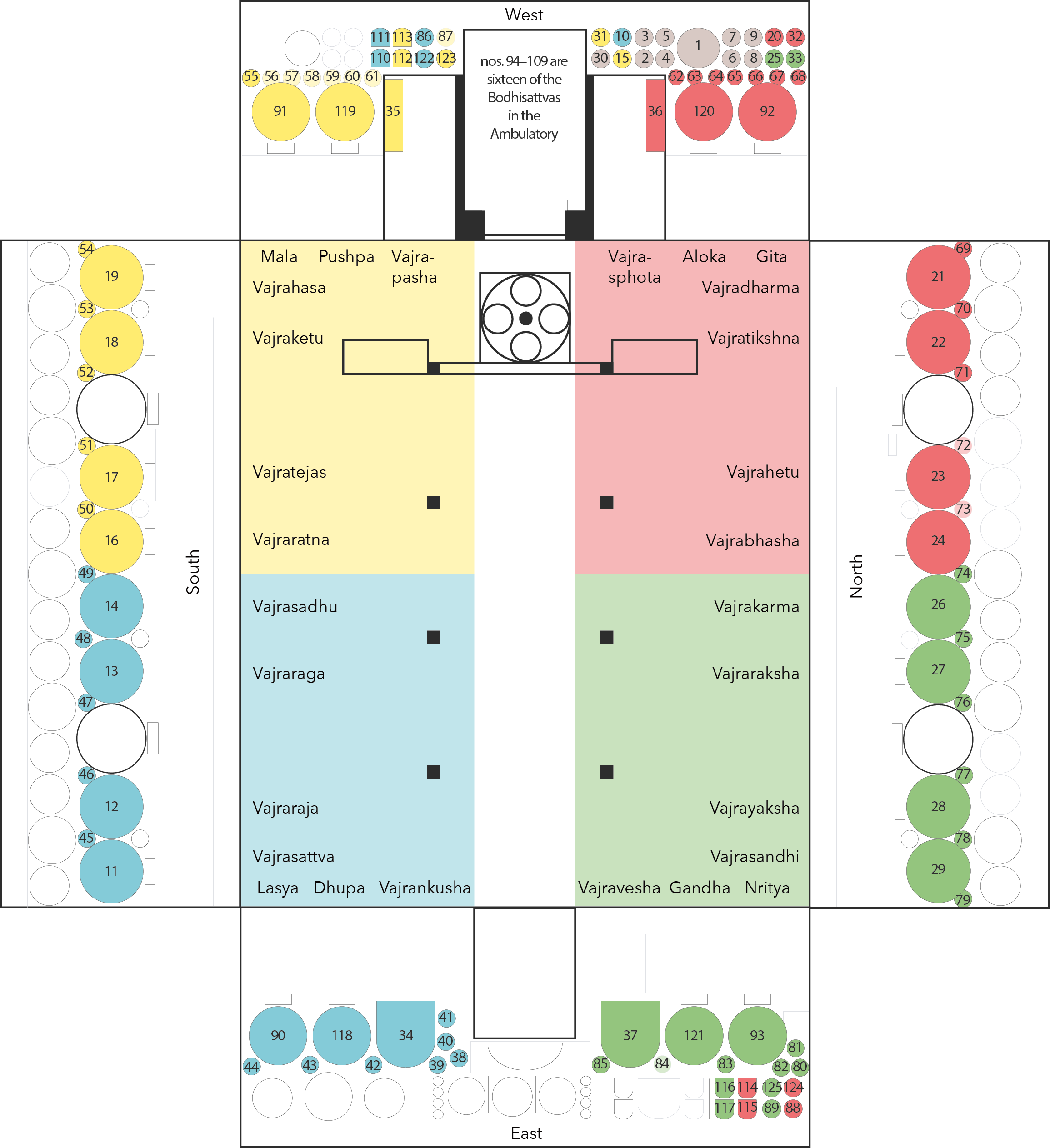
Complex Programme
The regular three-level decoration of the Tabo Assembly Hall datable to the renovation of the temple in the mid-eleventh century manifests a sophisticated iconographic programme, the principal elements of which are clear (◊ Assembly Hall). Its most striking feature are certainly the thirty-two clay sculptures placed side by side along the walls and centred on a four-fold Vairocana behind the altar. Together they represent the core assembly of a Vajradhātu mandala, which can be considered the dymanbic centre of the temples iconographic program.
Walking along the sculptures in circumambulation one follows the narratives of the ideal career of prince Sudhana (ནོར་བཟང་) in the southern half of the hall. This narrative is accompanied by text excerpts of the Gaṇḍavyūhasūtra, which have been studied in detail by Ernst Steinkellner. In the northern half of the hall is a depiction of the life of the Buddha expressing the contents of the Lalitavistara in expansive detail before wrapping up the story in tensly crowded scenes of events following the awakening.
Above the sculptures, the side walls feature the Buddhas of the Ten Directions each of them flanked by two Bodhisattvas. Above the images of the northern side of the west wall are the main deities of the Dharmadhātu mandala, the full assembly of which is distributed throughout the temple. This mandala, thus, constitutes the secret main theme of the monument. In contrast, the themes on the east wall are largely protective and include a mandala assembly of Vajravidāraṇa and the Protectors of the Three Families (རིགས་གསུམ་མགོན་པོ་).
- Steinkellner, Ernst. 1996. A Short Guide to the Sudhana Frieze in the Temple of Ta pho. Published on the Occasion of the Monastery's Millennium, Arbeitskreis für tibetische und buddhistische Studien, Universität Wien. Vienna.
- Steinkellner, Ernst. 1995. Sudhana's Miraculous Journey in the Temple of Ta pho. The inscriptional text of the Tibetan Gandavyuhasutra edited with introductory remarks, Serie Orientale Roma 76. Rome.

Vajradhātu Mandala Assembly
Together with the central four-fold Vairocana behind the altar the thirty-two sculptures along the walls represent the core deities of the Vajradhātu mandala. Besides the four images of the Buddha Vairocana seated on a common throne there are the four other esoteric Buddhas, sixteen Bodhisattvas, eight offering goddesses and four gate-keepers, the four groups of deities being differentiated by their aureoles and size. These sculptures are the most sophisticated clay sculptures that have survived until today. They can also be securely dated to the renovation in the middle of the 11th century (see the section on their mounting).
The esoteric Buddhas and their accompanying Bodhisattvas are seated along the south and north walls, while the goddesses are located in the corners of the east and west walls. The gate-keepers guard the entrance to the Assembly Hall at the east wall (E1 and E32) and the passage leading to the rear of the temple (W16 and W17). Of the two drawings below, the left one shows the arrangement of the mandala within the Assembly Hall, the respective quarters are linked to the gallery page with the Buddha heading the respective family. The right drawing provides the names of the deities the links leading to the quarter galleries that contain the repective deity among the ◊ Tabo Assembly Hall sculptures.

- Luczanits, Christian. 2004. Buddhist Sculpture in Clay: Early Western Himalayan Art, late 10th to early 13th centuries. Chicago: Serindia.

Dharmadhātu Mandala Assembly
Together with many of the deities of the Vajradhātu mandala represented in clay sculpture, paintings above the Vajradhātu Assembly represent the entire Dharmadhātu mandala assembly. Its main deities are painted on the north side of the west wall and complemented by the clay sculptures. The deities of the Dharmadhātu mandala’s second palace are mostly the goddesses painted in the upper areas between the main sculptures, and the deities of the outer palace are either painted on the west and east wall of the Assembly Hall or represented through the upper Bodhisattvas in the Ambulatory. The intricate integration of this assembly within the Main Temple identifies it as the temple's secret main topic.
The graphic below shows the distribution of the deities of this mandala with those of the same family and quarter distinquished by their family colour. Except for the five esoteric Buddhas, all other deities of the Vajradhātu mandala assembly are shared with the Dharmadhātu mandala assembly. The deities are presented in three image galleries, the painted image of the central palace in ◊ DMA (Dharmadhātu Mandala Assembly) Central Palace, the goddess of the second palace in ◊ DMA Second Palace, and the remaining deities of the third palace in ◊ DMA Third Palace.
The identificaitons are explained in detail in the following publication:
- Luczanits, Christian. “Mandalas Intertwined: Why Minor Goddesses in the Tabo Main Temple Matter.” In Burlesque of the Philosophers. Indian and Buddhist Studies in Memory of Helmut Krasser, ed. Vincent Eltschinger, Jowita Kramer, Parimal Patil, and Chizuko Yoshimizu, 363-394. Bochum, Freiburg: projekt verlag, 2023.

Mounting of the Mandala Sculptures
While originally it was thought that the mounting of the clay sculptures of the Assembly Hall implies that they have to be original to the building, a close survey of the sculptures in relation to the old paint layer made clear that they date to the renovation. This makes their mounting in a wall made of clay bricks a stunning achievement. It is said, that the posts supporting the sculptures have been inserted into holes drilled through the bricks. Thereby the sculpture is held by two poles to which the vertebral column of the image is attached. The lower pole is placed just above the rim of the circular halo, while the upper one marks it's centre. The lotus underneath is held by separate poles. The schematic drawing is based on this account.

